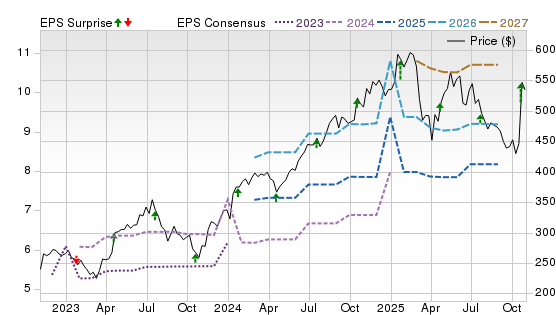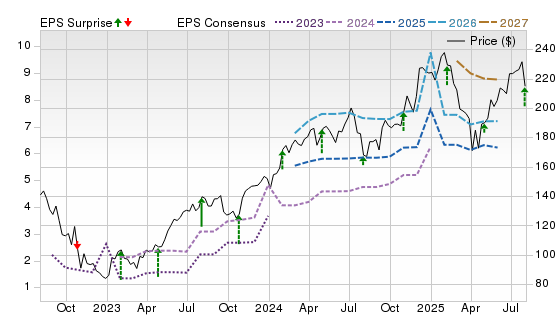5 Best AI Stocks to Buy Today
| Company (Ticker) | 12 Week Price Change | Forward PE | Price | Proj EPS Growth (1 Year) | Projected Sales Growth (1Y) |
|---|---|---|---|---|---|
| Micron Technology (MU) | 88.22% | 13.80 | $223.77 | 95.60% | 42.51% |
| Intuitive Surgical (ISRG) | 13.66% | 62.07 | $534.28 | 17.28% | 18.59% |
| Lam Research (LRCX) | 54.75% | 33.37 | $157.46 | 13.99% | 12.72% |
| Amazon.com (AMZN) | 9.67% | 35.01 | $244.22 | 26.15% | 11.68% |
| Meta Platforms (META) | -15.72% | 25.81 | $648.35 | 5.30% | 20.50% |
*Updated on November 2, 2025.
Micron Technology (MU)
$223.77 USD -0.24 (-0.11%)
3-Year Stock Price Performance

Premium Research for MU
- Zacks Rank
- Strong Buy 1
- Style Scores
B Value A Growth F Momentum B VGM
- Market Cap: $249.09B (Large Cap)
- Projected EPS Growth:95.66%
- Last Quarter EPS Growth:65.32%
- Last EPS Surprise:5.94%
- Next EPS Report date:Dec. 17, 2025
Our Take:
Micron is a leading supplier of Dynamic Random Access Memory (DRAM), NAND, and high-bandwidth memory that underpins AI accelerators and data-center servers. The company began volume production of HBM3E for NVIDIA’s H200 platform and is scaling next-gen stacks, positioning it squarely in the AI build-out.
Its Zacks Rank #1 (Strong Buy) underscores positive estimate revisions. At the same time, Style Scores of A for Growth and B for Value suggest improving earnings power at a reasonable valuation despite cyclical volatility. Its roadmap emphasizes power-efficient HBM and LPDDR solutions for AI accelerators, strengthening both unit and product mix tailwinds as adoption continues to expand.
Micron’s Price, Consensus & EPS Surprise chart shows a pronounced turn from the 2023 trough, with 2025–2027 EPS estimates trending higher and the stock price following an upward trajectory. The recent pullbacks have not derailed the multi-year estimate uptrend, indicating that revision momentum remains intact alongside the AI memory cycle.
Intuitive Surgical (ISRG)
$534.28 USD +4.26 (0.80%)
3-Year Stock Price Performance

Premium Research for ISRG
- Zacks Rank
 Hold 3
Hold 3
- Style Scores
D Value C Growth B Momentum D VGM
- Market Cap: $195.51B (Large Cap)
- Projected EPS Growth: 17.30%
- Last Quarter EPS Growth: 7.10%
- Last EPS Surprise: 20.60%
- Next EPS Report date:Jan. 22, 2026
Our Take:
Intuitive is the leader in robotic-assisted surgery. Its da Vinci 5 platform adds 10,000x computing power and software features that deliver real-time surgical insights and AI-enabled workflow enhancements.
Its Zacks Rank #2 (Buy) with Style Scores of D for Value, C for Growth, and A for Momentum conveys premium valuation offset by accelerating adoption and positive price action, which is an acceptable trade-off if procedure momentum persists.
On the chart, shares stair-step higher with 2026–2027 EPS estimates rising, suggesting upgrades are translating into expectations for faster utilization and service growth. With a sticky ecosystem and accelerating digital features, ISRG’s momentum score looks supported by improving consensus.
Lam Research (LRCX)
$157.46 USD -3.55 (-2.20%)
3-Year Stock Price Performance

Premium Research for LRCX
- Zacks Rank
 Strong Buy 1
Strong Buy 1
- Style Scores
D Value A Growth D Momentum C VGM
- Market Cap:$182.90B (Large Cap)
- Projected EPS Growth:9.42%
- Last Quarter EPS Growth:27.88%
- Last EPS Surprise:10.83%
- Next EPS Report date:Oct. 22, 2025
Our Take:
Lam Research supplies etch and deposition tools essential to leading-edge logic (including gate-all-around) and high-layer 3D memory, steps that scale with AI chip complexity. A Zacks Rank #2 (Buy) coupled with a Style Score of B for Momentum reflects improving orders and estimate traction through the upturn, while Value and Growth scores of D and C, respectively, suggest investors are paying up for cycle leverage.
Lam’s Akara conductor-etch platform and automation initiatives aim to maximize yield and throughput for next-gen nodes and 3D DRAM/NAND, aligning the company with secular AI demand for advanced wafers. As a fabs tool for GAA and denser memory to feed accelerators, Lam’s installed base and process leadership should benefit.
The chart shows price rebounding with steady increases in 2025–2027 EPS consensus after last cycle’s trough, consistent with a mid-cycle recovery. Estimate lines trending higher ahead of price suggest continued support for the Buy rating.
Amazon.com (AMZN)
$244.22 USD +21.36 (9.58%)
3-Year Stock Price Performance

Premium Research for AMZN
- Zacks Rank
 Buy 2
Buy 2
- Style Scores
C Value B Growth A Momentum B VGM
- Market Cap:$2,444.93B (Large Cap)
- Projected EPS Growth:23.69%
- Last Quarter EPS Growth:5.66%
- Last EPS Surprise:26.32%
- Next EPS Report date:Oct. 30, 2025
Our Take:
Amazon’s AI exposure centers on AWS, which offers Bedrock for foundation-model access and custom Trainium/Inferentia chips. Also, deepened ties with Anthropic position AWS as a full-stack AI platform.
Its Zacks Rank #2 and Style Scores of C for Value, A for Growth, and B for Momentum align with accelerating AI workloads, broader Bedrock capabilities (including multi-agent features), and differentiated price-performance from Trainium2. These should reinforce AWS's growth and operating leverage.
The chart shows shares trending higher alongside steady climbs in 2026–2027 EPS estimates, indicating that consensus is baking in AI-driven margin and revenue expansion. With model breadth and custom silicon, AMZN remains a high-quality AI infrastructure beneficiary.
Meta Platforms (META)
$648.35 USD -18.12 (-2.72%)
3-Year Stock Price Performance

Premium Research for META
- Zacks Rank
 Hold 3
Hold 3
- Style Scores
C Value A Growth A Momentum A VGM
- Market Cap: $1,887.72B (Large Cap)
- Projected EPS Growth:18.23%
- Last Quarter EPS Growth: 11.04%
- Last EPS Surprise:22.47%
- Next EPS Report date:Oct. 29, 2025
Our Take:
Meta is weaving AI across its family of apps and devices, open-sourcing Llama models and rolling out the Meta AI assistant globally, supported by outsized infrastructure investment.
Its Zacks Rank #2 with Style Scores of C for Value, A for Growth, and B for Momentum reflects strong earnings power and improving trend, with valuation balanced by significant spend. Meta continues to accelerate Llama’s release cycle, expanding its accessibility to developers and supporting a wider range of workloads.
On the chart, the stock’s uptrend is supported by rising 2026–2027 EPS lines, suggesting durable estimate revisions as AI infrastructure and models roll out. With robust momentum and tangible AI leverage across its platforms, META’s quantitative profile looks well supported.
Methodology
The Zacks Rank is a proprietary stock-rating model that uses trends in earnings estimate revisions and earnings-per-share (EPS) surprises to classify stocks into five groups: #1 (Strong Buy), #2 (Buy), #3 (Hold), #4 (Sell) and #5 (Strong Sell). The Zacks Rank is calculated through four primary factors related to earnings estimates: analysts' consensus on earnings estimate revisions, the magnitude of revision change, the upside potential and estimate surprise (or the degree in which earnings per share deviated from the previous quarter).
Zacks builds the data from 3,000 analysts at over 150 different brokerage firms. The average yearly gain for Zacks Rank #1 (Strong Buy) stocks is +23.62% per year from January, 1988, through June 2, 2025.
Selections for Best AI Stocks are based on the current top ranking stocks based on Zacks Indicator Score. For this list, only companies that have average daily trading volumes of 100,000 shares or more and at least five analysts covering the stock were considered. All information is current as of market open, Oct. 29, 2025.
Guide to AI Stocks
The classification of “AI Stocks” is actually quite broad, ranging from companies that provide the essential hardware, companies that create the software to run Large Language Models, and a whole host of other industries and companies that are creating the Artificial Intelligence ecosystem. All stand to gain – or lose – depending on the fortunes of AI tech.
Types of AI Stocks
Hardware (GPUs, Chips) Stocks – NVIDIA, AMD, TSMC, Broadcom
The backbone of AI is raw computing power, and this comes primarily from specialized chips like graphics processing units (GPUs) and AI-focused accelerators. NVIDIA (NVDA) is the undisputed leader in GPUs used for training large language models.
Advanced Micro Devices (AMD) is a rising competitor, with its MI300 series targeting data center AI workloads. Taiwan Semiconductor Manufacturing Co. (TSMC) doesn’t make its own chips but manufactures advanced nodes for nearly every big tech firm—including Apple, Nvidia, and AMD—making it critical to the global AI supply chain. Broadcom (AVGO) has carved a niche in custom ASICs (application-specific integrated circuits) for hyperscale cloud providers, which value tailored chips that reduce energy use and maximize throughput.
These companies benefit from structural demand for more computing capacity, but they also face geopolitical risks such as U.S.-China export restrictions and cyclical swings in semiconductor demand.
AI Cloud & Infrastructure – Microsoft, Amazon, Alphabet
Building AI applications at scale requires massive computing infrastructure. Azure from Microsoft (MSFT) has become a leader by integrating OpenAI’s models directly into its cloud offerings, giving it a first-mover advantage in AI enterprise adoption. Amazon Web Services, a subsidiary of Amazon (AMZN) is deploying its in-house Trainium and Inferentia chips, aiming to lower costs for AI workloads while retaining dominance in cloud services. Alphabet’s (GOOG) Google Cloud is leaning heavily on its proprietary Tensor Processing Units (TPUs) and Gemini AI models to differentiate itself.
Investing in these players is less about speculative growth and more about diversified tech giants whose AI investments bolster an already profitable core business.
Enterprise AI Software & Analytics – Palantir, C3.ai, Adobe, Snowflake
AI isn’t just about hardware; software platforms are where businesses actually apply machine intelligence. Palantir (PLTR) powers decision-making for defense and large corporations with its Foundry and Gotham platforms. C3.ai (AI) focuses specifically on AI-driven applications across industries like energy, finance, and manufacturing. Adobe (ADBE) has integrated AI across its creative suite (e.g., Firefly in Photoshop), while Snowflake (SNOW) has added AI-enabled analytics to its cloud data warehousing business.
These stocks tend to have higher growth potential but also higher risk, as adoption timelines and customer budgets can vary widely.
Cybersecurity AI – CrowdStrike
The rise of AI also heightens cyber risks. CrowdStrike (CRWD) leads in AI-powered threat detection, using machine learning to flag suspicious behavior across millions of endpoints in real time. With ransomware and nation-state attacks increasing, demand for AI-driven security remains strong. Cybersecurity names often benefit from recurring revenue models, which may help smooth out volatility compared to hardware peers.
Benefits and Risks of AI Stocks
Benefits:
- Secular Growth: AI adoption is still in early innings, with enterprise use cases expanding rapidly.
- Diversified Exposure: Investors can target infrastructure, software, or services depending on risk tolerance.
- First-Mover Advantage: Leaders like NVIDIA and Microsoft are shaping the ecosystem, creating strong economic moats.
Risks:
- Valuations: Many AI leaders are priced for perfection, leaving little margin of safety.
- Hype Cycle: Investor enthusiasm may outrun near-term fundamentals, creating bubble risk.
- Regulation: Governments are exploring AI rules around privacy, bias, and national security, which could reshape business models.
- Competition: Barriers to entry are high, but fast innovation means today’s leader can quickly lose ground.
How to Choose AI Stocks
When evaluating AI stocks, consider:
- Revenue Mix: How much of the company’s growth is truly driven by AI vs. traditional segments?
- Moat & Differentiation: Does the company control unique technology (like NVIDIA’s CUDA software ecosystem)?
- Customer Adoption: Look for companies with recurring contracts or wide adoption across industries.
- Financial Health: Strong balance sheets matter in a capital-intensive industry.
- Valuation Metrics: Compare price-to-earnings (P/E) ratio, price-to-sales (P/S) ratio, and forward growth projections to industry peers.
How to Invest in AI Stocks
There are multiple entry points depending on your goals:
- Direct Stock Picks: Best if you want concentrated exposure to specific company leaders or disruptors.
- AI Exchange-Traded Funds (ETFs): ETFs such as Global X Robotics & Artificial Intelligence ETF (BOTZ) or iShares Robotics and AI ETF (IRBO) provide diversification by investing in a broad range of companies in the AI space.
- Broad Tech ETFs: Like Invesco QQQ (QQQ) or Vanguard Information Technology ETF (VGT), offering AI exposure as part of a bigger tech basket.
- Dollar-Cost Averaging (DCA): A strategy to smooth price volatility by buying at regular intervals AI stocks or funds.
- Long-Term Holds: Since AI is a multi-decade trend, investors who can weather short-term swings may see the best results.
AI Stocks Alternatives
If you want exposure to AI without betting on a single stock:
- ETFs: Offer diversification and reduce single-company risk.
- Private Markets: Startups in robotics, generative AI, and enterprise AI could offer upside, though access is limited to accredited investors, which face income or licensing limitations (such as a net worth of $1 million, excluding primary residence, plus a high annual income – $300,000 if married.
- Picks-and-Shovels Plays: Companies supplying infrastructure, like power management (e.g., Eaton) or data center REITs (e.g., Equinix), benefit indirectly from AI growth.
Strategies for AI Stocks Moving Forward
- Barbell Approach: Combine stable mega-caps (Microsoft, Nvidia) with speculative names (Quantum Computing Inc., Credo) for balanced exposure.
- Rebalancing: Trim positions after strong rallies to lock in gains and redeploy into underweighted sectors.
- Monitor Earnings: Focus on whether AI adoption translates into sustainable revenue growth.
- Look Beyond the U.S.: Consider emerging AI leaders in Europe and Asia for diversification.
- Stay Agile: AI is evolving rapidly; reassess holdings every quarter as new winners emerge.
Frequently Asked Questions About AI Stocks
Are AI stocks overvalued?
Many AI leaders are priced at steep multiples compared to the broader market. That doesn’t mean all are bubbles, but investors should separate hype from earnings-driven growth.
What is the forecast for AI stocks?
Most analysts expect AI demand to expand through at least the next decade, with data center spending, AI-as-a-service, and AI-enabled enterprise tools driving revenue.
What metrics best signal AI efficacy?
- Growth in AI-specific revenue lines.
- Gross margin improvements tied to AI.
- Customer retention and expansion.
- Evidence of scale: Contracts, partnerships, recurring revenue.














